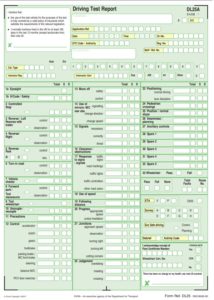Reversing Exercises
There are two reversing exercises that you will have to demonstrate on your Part Two test from a selection of four exercises:
· Parallel/reverse park at the side of the road
· Reverse into a parking bay and drive out
· Drive forwards into a parking bay and reverse out
· Pull up on the right-hand side of the road, reverse 2 car lengths and rejoin the traffic
Each exercise requires you to demonstrate:
· Excellent steering and clutch control
· Proper observation all-round your vehicle and appropriate action to other road users
· That you can manoeuvre accurately between, or close to, kerbs and bays
You may remove your seat belt when carrying out a manoeuvre which involves reversing.
Click on each of the items below for more information along with some common faults
- Left Reverse
(not tested) - Right Reverse
(not tested) - Reverse Parking
(Road) - Reverse Parking
(Car Park) - Turn in the Road
(not tested) - Forward Park
Left Reverse (not tested)
Observation. Make regular, all-round checks for other road users as you carry out your reversing. Though you should look mainly over your left shoulder as you reverse, it is permissible to look into the near side door mirror occasionally to check your proximity to the kerb.
Try to keep no more than 0.5m (1.5ft) from the kerb at all times. If you brush the kerb, move forwards slightly and then reverse again correcting your error. Be prepared to wait for other road users to pass you; if they wait, continue reversing but check regularly to ensure it remains safe to proceed.
Control. Keep a careful balance between clutch and accelerator as you reverse slowly. About a half turn of the steering wheel should be applied to the left once the rear wheel of your vehicle has reached the start of the corner. This will vary according to whether the turn is sharp or gentle (i.e. apply over one full turn if it is a sharp corner). Correct your steering as you reverse. Reverse back until you can see 3 hazard lines in the centre of the road ahead of you.
Right Reverse (not tested)
Observation. The general rules for reversing also apply to reversing into a side road on the right. However, when reversing around the corner, look over your right shoulder. Change back to the left shoulder when you have straightened your wheel in the new road (side road).
Reverse back at least 25m into the new road (so that you can see 5 hazard lines down the centre of the side road ahead of you). This will give you plenty of room to manoeuvre safely back to the left in order to emerge at the ‘T’ junction.
Having the driver’s door window down helps judge the point of turn at the corner. You can look into the side road more easily.
Control Keeping close to the kerb on the right (a steering wheel width), when reversing to and from the corner whilst looking over your left shoulder, is not easy and takes some practice to perfect. Ensure your vehicle is parallel to the kerb and the steering wheel is straight before reversing. This will reduce the need to steer as you start reversing in a straight line.
Reverse Parking – Road
There are a variety of methods and useful tips of the trade which will assist you to complete a good reverse park. It is for you to use the tips which suit you.
Observation. Use good, effective all-round observation while reversing. Look mainly over your left shoulder as you reverse but check all-round regularly for other road users who might be affected by your manoeuvre. Be prepared to stop if necessary.
Control. Demonstrate excellent co-ordination of clutch, accelerator and footbrake. Once you have pulled up alongside the parked car, keeping up to 1m from it, select reverse gear straight away to inform following road users of your intentions. Use the parking brake if necessary. Reverse so that the vehicles are side-by-side then steer left one full turn. Once the car is about 45 degrees to the kerb, apply full lock to the right. Straighten the wheel (left 1.5 turns) as the car is almost parallel and close to the kerb.
You should aim to park into a space of about 1.5 – 2 vehicle lengths. Be close to the kerb and parallel to it when you have completed the manoeuvre, as if you were parking and leaving the vehicle
Reverse Parking – Car Park
You may be asked to carry out a reverse into a car parking bay either at the start or end of your test. The examiner usually points out the bay you should reverse into.
You must practice reversing both to the right and the left into bays. Establish useful reference points when looking through the rear and side windows to help with your point of turn. Treat the bay park the same as a reverse around a very sharp corner; you will probably need full lock.
Aim to park first time, squarely in the bay, with your wheels straight and with enough room to open the doors safely.
Turn In The Road – Not Tested
The Guide to Learning to Drive book adequately covers the requirements of the turn in the road for the Part Two test. You should try to complete the manoeuvre in three moves and show due consideration for other road users.
Observation. Check mirrors and all round for other road users prior to moving away each time from the kerb. Also check left and right when crossing the road when going both forwards and in reverse. If you might impede another road user, wait at the kerb until they have passed. If they wait, continue with the manoeuvre. Never drive towards pedestrians on the kerb.
Control. Always steer briskly and attempt to achieve full lock quickly. Counter-steer when quite close to the kerb (1m from it) keeping the clutch close to the biting point in order to move the vehicle very slowly. Apply the parking brake when close to the kerb if necessary to avoid rolling down she camber. Don’t “dry” steer.
Forward Park
This is a new manoeuvre added to the driving test and Part Two test. You will be asked to find a suitable place to park on the right side of the road. The examiner will then direct you to reverse about two car lengths keeping the car close and parallel to the kerb. You will then be asked to move off to rejoin the traffic flow.
Correct application of the MSM routine is key to parking up and moving off again. Ensure effective all-around observations are made during the reverse. Consider lowering the right door mirror to help with judgement of the kerb. The most difficult part of the manoeuvre will probably be moving off again safely to the left lane. Take care to ensure you do not affect any other road users.
Private Practice on Manoeuvres
It is important that you take the time to practice the control exercises (manoeuvres) in a variety of conditions. Record each attempt on the forms provided after this section. Discuss your practice with your trainer and work on any weak areas that you discover


